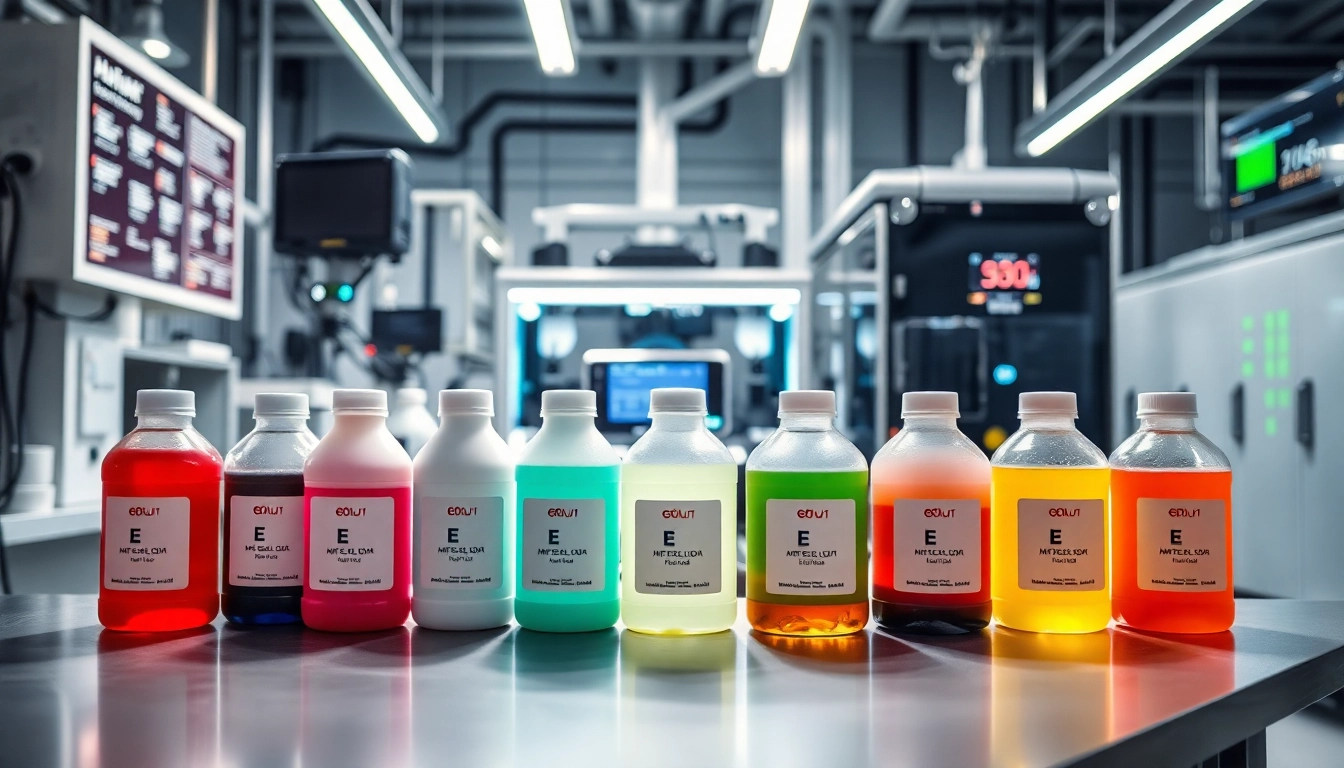1. What are E Fluids?
In a world increasingly dominated by electric vehicles (EVs), understanding the components that enhance their performance has become vital. Among these components, e fluids play a crucial role. But what exactly are e fluids? E fluids, or electric fluids, encompass a range of specialized liquids designed specifically for electric vehicles and hybrid systems. These fluids serve various functions, including lubrication, cooling, and temperature management in vehicle systems.
1.1 Definition and Types of E Fluids
E fluids can be broadly categorized into several types, each crafted for specific applications within electric vehicles:
- E-Transmission Fluids: Used for lubrication and cooling within the transmission system.
- E-Thermal Fluids: Designed to manage heat within electric motors and components.
- E-Greases: Used in bearings and joints to ensure the longevity and optimal performance of moving parts.
- E-Cooling Fluids: Essential for regulating temperature to prevent overheating, optimizing battery life, and maintaining effective performance during operation.
1.2 Importance in Electric Vehicles
The significance of e fluids in electric vehicles cannot be overstated. They directly impact the efficiency, durability, and performance of electric powertrains. As electric vehicles operate under different conditions compared to traditional internal combustion engines, specifically formulated e fluids are essential for enhancing vehicle performance and extending the lifespan of critical components. This leads to a reduction in maintenance costs and improvements in energy efficiency.
1.3 Key Characteristics and Properties
For a fluid to be deemed an effective e fluid, it must exhibit specific characteristics:
- High Thermal Stability: E fluids must withstand high temperatures without degrading.
- Good Lubrication Properties: They should minimize friction and wear in mechanical components.
- Low Volatility: E fluids should have a low tendency to evaporate, ensuring extended efficacy.
- Compatibility: They need to be compatible with various materials used in electric vehicles, including seals, gaskets, and electronic components.
- Eco-friendliness: Many formulations focus on being environmentally friendly, with lower toxicity levels promoting sustainability.
2. The Role of E Fluids in Electric Vehicles
E fluids are crucial in several systems within electric vehicles, serving unique roles compared to traditional fluids. Understanding these applications better can illuminate their importance.
2.1 E Fluids for Cooling Systems
Cooling systems in electric vehicles are critical for preventing overheating, especially given the high energy output during operation. E thermal fluids help maintain optimal temperatures for batteries and electric motors, ensuring efficient operation. For example, liquid cooling systems often circulate specially designed cooling fluids that absorb and dissipate heat through a radiator or heat exchanger, maintaining the optimal operating temperature for the EV’s components. Advanced formulations now provide enhanced thermal conductivity, allowing for more effective heat transfer and improved overall system performance.
2.2 E Fluids for Transmission and Drivetrain
E fluid formulations for transmissions are specifically designed to endure variable temperatures and high performance loads found in electric vehicles. These transmission fluids provide essential lubrication, ensuring that gears and bearings function smoothly while minimizing wear and tear. Furthermore, as electric drivetrains differ significantly from traditional designs, e fluids must also safeguard against the rapid acceleration and deceleration characteristic of electric motors, thus prolonging the lifespan of the drivetrain components.
2.3 E Fluids for Battery Management
The management of thermal conditions within batteries is crucial for performance, longevity, and safety. E fluids designed specifically for battery cooling and thermal management systems ensure even heat distribution, preventing hotspots and optimizing charge and discharge cycles. As electric vehicle manufacturers continue to innovate, the development of smart e fluids that can respond to changing operating conditions—improving thermal regulation dynamically—holds tremendous potential.
3. Benefits of Using E Fluids
The integration of e fluids in electric vehicles offers numerous advantages, enhancing performance, protection, and sustainability.
3.1 Enhanced Performance and Efficiency
One of the most noticeable benefits of using e fluids is the enhancement of vehicle performance and efficiency. The unique characteristics of e fluids allow for reduced friction and better heat management, resulting in smoother operation and increased energy efficiency. This efficiency translates into longer ranges per charge and improved overall energy use, critical factors for consumers and manufacturers in the competitive electric vehicle market.
3.2 Improved Longevity and Equipment Protection
The protective qualities of e fluids are significant; they not only extend the life of components but also ensure reliable operation. For instance, e transmission fluids capable of withstanding high pressures and thermal variations can significantly reduce the risk of failure in critical drivetrain components, allowing them to operate optimally over time without frequent maintenance needs. Expert Tip: Regularly checking fluid levels and characteristics can preempt potential issues, ensuring longevity and robustness.
3.3 Environmental Advantages of E Fluids
With a growing focus on sustainability, e fluids often utilize environmentally friendly components with lower toxicity levels compared to traditional oils. This makes electric vehicles not only cleaner in terms of emissions but also in their operation, since the fluids contribute to a smaller ecological footprint throughout their lifecycle. As such, they support the larger goals of reducing the automotive industry’s carbon footprint while ensuring efficient vehicle operation.
4. Comparing E Fluids with Traditional Fluids
As the automotive industry transitions towards electric and hybrid vehicles, a robust understanding of how e fluids compare with traditional fluids is essential.
4.1 Performance Metrics of E Fluids vs. Conventional Oils
When evaluating performance metrics, e fluids demonstrate superior characteristics relative to conventional oil formulations. For instance, e fluids typically show higher thermal stability and lower volatility, making them less prone to evaporation and degradation under extreme conditions. Furthermore, their tailored viscosity grades deliver better lubrication in high-performance situations typical of electric vehicles, leading to enhanced fuel economy and energy efficiency.
4.2 Cost Analysis: E Fluids vs. Traditional Solutions
While the initial investment in e fluids may be higher compared to conventional oils, the long-term savings and benefits outweigh the costs. E fluids tend to offer longer intervals between changes due to their advanced formulations, thus saving on maintenance costs. Additionally, the improved efficiency of EVs using e fluids can lead to lower energy costs over time. The analysis often shows that although consumers may pay more upfront, they ultimately achieve substantial cost savings through reduced maintenance and enhanced vehicle longevity.
4.3 Technological Advances Influencing E Fluids
The continuous advancements in technology, especially in material sciences and chemistry, are paving the way for innovative e fluid formulations that are more efficient and environmentally friendly. These innovations include the incorporation of nanomaterials for enhancing lubricity and thermal conductivity, as well as bio-based ingredients that not only improve performance but also align with the industry’s shift towards sustainable practices. The evolution of e fluids demonstrates how technological progress can dramatically influence the effectiveness and sustainability of automotive applications.
5. Future Trends in E Fluids Development
As electric vehicle adoption accelerates, the development of e fluids continues to evolve. Observing emerging trends can provide insights into the future of automotive lubricants.
5.1 Innovations in Fluid Formulation
The future will likely see even more robust formulations of e fluids that cater to the unique requirements of next-generation electric vehicles. Innovations focusing on reducing viscosity while enhancing lubrication properties are critical, accommodating the increasing power demands and performance expectations from consumers and manufacturers alike. Manufacturers are exploring synthetic options and additives that optimize these new formulations to ensure peak performance under varying driving conditions.
5.2 Impact of Regulatory Changes on E Fluids
With increasing regulations aimed at reducing environmental impacts and promoting sustainability, the formulation of e fluids is likely to adjust accordingly. Regulatory bodies are advocating for stricter standards on emissions and sustainability practices which will push manufacturers to develop even cleaner, more efficient e fluids that comply with the latest environmental standards while maintaining high performance. This shift aligns with global trends in reducing reliance on fossil fuels and enhancing the overall sustainability of the automotive sector.
5.3 The Role of E Fluids in the Growing EV Market
The rapid growth of the electric vehicle market signifies an urgent demand for high-performance, reliable e fluids. As automotive manufacturers focus on increasing the efficiency and performance of electric vehicles, there will be a corresponding rise in demand for advanced e fluids. Investment in research and innovation will not only enhance product offerings but also ensure that e fluids meet the evolving needs of the market, providing a competitive advantage to manufacturers who prioritize such developments.



